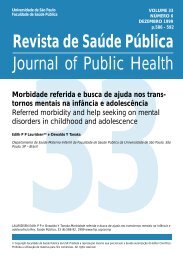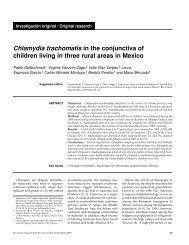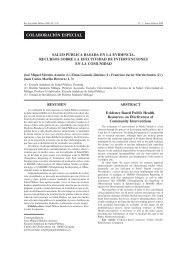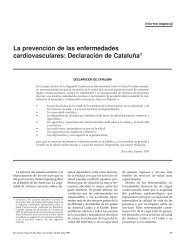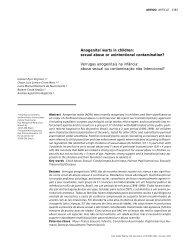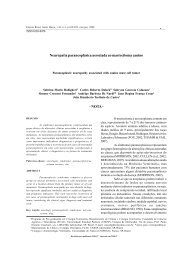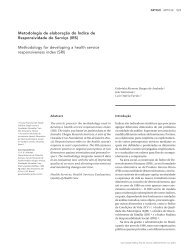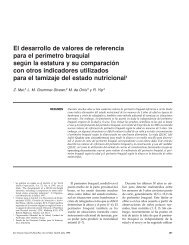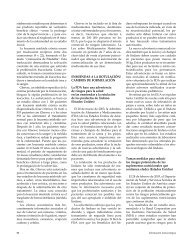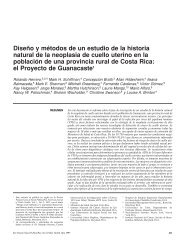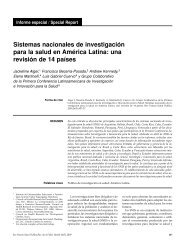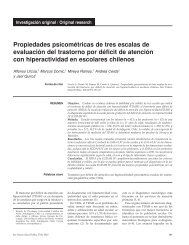Nível de atividade física de crianças e adolescentes órfãos ... - SciELO
Nível de atividade física de crianças e adolescentes órfãos ... - SciELO
Nível de atividade física de crianças e adolescentes órfãos ... - SciELO
Create successful ePaper yourself
Turn your PDF publications into a flip-book with our unique Google optimized e-Paper software.
Abstract<br />
Objective: To estimate the level of physical<br />
activity among children and adolescents<br />
orphaned by AIDS according to socio-<strong>de</strong>mographic<br />
and orphanhood-related characteristics.<br />
Methods: A population-based<br />
study was carried out with 235 children and<br />
adolescents aged 7 to 14 years in the municipality<br />
of São Paulo, SP, in 2007. Children<br />
were classified as active and inactive. The<br />
cut-off point established was 300 minutes<br />
of weekly physical activity. All variables were<br />
compared between both groups and sexes.<br />
Results: An overall prevalence of 42% of<br />
inactivity was found. Active commuting and<br />
child’s play were the main physical activities<br />
for most of the children and adolescents.<br />
As for physical activity level, a significant<br />
difference was observed between sexes (p<br />
< 0.001). Boys were more active and played<br />
outdoors more than girls. Conclusions:<br />
There is a high prevalence of physical inactivity<br />
among children and adolescents<br />
orphaned by AIDS, especially girls.<br />
Keywords: AIDS. Orphans. Physical activity.<br />
Inactivity. Children. Play.<br />
Introdução<br />
No Brasil, uma das consequências da<br />
heterossexualização da epi<strong>de</strong>mia <strong>de</strong> aids<br />
nos últimos <strong>de</strong>z anos foi o aumento da<br />
proporção <strong>de</strong> <strong>crianças</strong> filhas <strong>de</strong> pessoas<br />
vivendo com HIV. Consi<strong>de</strong>rando-se a baixa<br />
probabilida<strong>de</strong> <strong>de</strong> transmissão vertical1 , sobretudo<br />
se a gestação tiver acompanhamento<br />
pré-natal, a maioria <strong>de</strong>ssas <strong>crianças</strong> não<br />
é soropositiva para o HIV. Algumas <strong>de</strong>stas<br />
<strong>crianças</strong> po<strong>de</strong>m ficar órfãs em <strong>de</strong>corrência<br />
da morte <strong>de</strong> um ou ambos os pais pela aids.<br />
Estudos mostram que a orfanda<strong>de</strong> por aids<br />
po<strong>de</strong> vir acompanhada <strong>de</strong> impactos negativos,<br />
afetando a saú<strong>de</strong>2 .<br />
Na literatura, os estudos sobre a saú<strong>de</strong><br />
<strong>de</strong> <strong>órfãos</strong> em consequência da aids são majoritariamente<br />
relacionados à saú<strong>de</strong> mental<br />
(estresse, baixa auto-estima e <strong>de</strong>pressão) 3,4<br />
e aos aspectos nutricionais (prevalência <strong>de</strong><br />
<strong>de</strong>snutrição) 5 . Entretanto, não há estudos<br />
sobre o nível <strong>de</strong> ativida<strong>de</strong> <strong>física</strong> entre <strong>crianças</strong><br />
órfãs <strong>de</strong>vido à aids.<br />
Para a boa saú<strong>de</strong> e o bom <strong>de</strong>senvolvimento6-8<br />
<strong>de</strong> <strong>crianças</strong> e jovens é recomendável<br />
prática regular <strong>de</strong> ativida<strong>de</strong> <strong>física</strong>, <strong>de</strong>finida<br />
como “qualquer movimento corporal,<br />
produzido pelos músculos esqueléticos,<br />
que resulte em gasto energético maior que<br />
os níveis <strong>de</strong> repouso” 9 .<br />
Apesar da contribuição da ativida<strong>de</strong> <strong>física</strong><br />
na saú<strong>de</strong> e na qualida<strong>de</strong> <strong>de</strong> vida <strong>de</strong> <strong>crianças</strong><br />
e <strong>adolescentes</strong>, tem-se observado alta prevalência<br />
<strong>de</strong> se<strong>de</strong>ntarismo10,11 , principalmente<br />
entre as meninas, <strong>crianças</strong> com menor grau <strong>de</strong><br />
escolarida<strong>de</strong> e com baixo nível econômico. 12<br />
Assim, neste estudo estimamos o nível<br />
<strong>de</strong> ativida<strong>de</strong> <strong>física</strong> <strong>de</strong>stas <strong>crianças</strong> e<br />
examinamos suas diferenças segundo as<br />
características socio<strong>de</strong>mográficas e aquelas<br />
relativas à orfanda<strong>de</strong>.<br />
Material e Método<br />
Sujeitos<br />
Uma amostra probabilística foi construída<br />
para este estudo transversal <strong>de</strong> base<br />
populacional.<br />
<strong>Nível</strong> <strong>de</strong> ativida<strong>de</strong> <strong>física</strong> <strong>de</strong> <strong>crianças</strong> e <strong>adolescentes</strong> <strong>órfãos</strong> por aids<br />
Barros, C.R.S. et al.<br />
447<br />
Rev Bras Epi<strong>de</strong>miol<br />
2010; 13(3): 446-56





